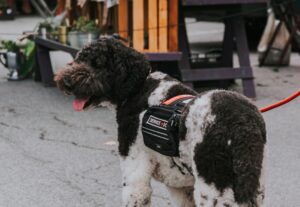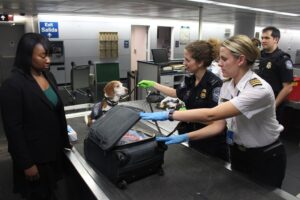When talking about dogs that offer help and support to humans, there are different types that come to mind. Service dogs, therapy dogs, working dogs and support dogs are frequently discussed, although not everyone may be aware of the distinctions between them. In this article, we will delve into the distinct roles and functions of service dogs, therapy dogs, and support dogs and gain a better understanding of how each of these remarkable animals significantly impacts the lives of those they assist.
Service Dogs
Service dogs are extensively trained animals that perform particular duties for people with disabilities. These dogs go through intensive training programs to acquire the necessary skills to assist their handlers in a variety of tasks, such as guiding those with vision impairments or notifying individuals with epilepsy about an upcoming seizure. In accordance with the Americans with Disabilities Act (ADA), service dogs are allowed to accompany their handlers in public areas, including those with regulations prohibiting pets. 
Some examples of service dogs include:
- Guide dogs for the visually impaired
- Hearing dogs for the deaf or hard of hearing
- Mobility assistance dogs for people with physical disabilities
- Diabetic alert dogs for individuals with diabetes
- Seizure alert/response dogs for people with epilepsy
Working Dogs
A trained canine with a specific purpose is known as a working dog. These dogs acquire skills and carry out tasks to aid humans. Various examples of working dogs are those trained for detection, herding, hunting, search and rescue, police work, and military operations. Since working dogs are typically prepared for particular roles in specific locations, they are usually not subject to legal consequences. However, when these dogs are on duty, it is important not to approach or pet them, as their job requires a high level of concentration without distractions. Working dogs often rely on their exceptional sense of smell to assist where humans may be lacking. Some of the tasks they perform include:
Various examples of working dogs are those trained for detection, herding, hunting, search and rescue, police work, and military operations. Since working dogs are typically prepared for particular roles in specific locations, they are usually not subject to legal consequences. However, when these dogs are on duty, it is important not to approach or pet them, as their job requires a high level of concentration without distractions. Working dogs often rely on their exceptional sense of smell to assist where humans may be lacking. Some of the tasks they perform include:
- Search and rescue: Search and rescue dogs possess the ability to track down their targets by either detecting a particular scent in the atmosphere or by relying on the scent of a specific item. These remarkable canines find application in a diverse range of scenarios, encompassing disasters, attempts to recover deceased individuals, water-related emergencies, and instances of avalanches. This role is frequently fulfilled by bloodhounds due to their widespread usage.
- Explosives detection: These heroic canines collaborate with law enforcement agencies, the Transportation Security Administration (TSA), and the armed forces to detect hazardous substances. The dogs undergo rigorous training sessions to acquire the skills of detecting and recognizing various types of explosives, as well as notifying their handlers when they find them. The German Shepherd and Belgian Malinois breeds demonstrate exceptional proficiency in these tasks.
- Cancer detection: It may be surprising, but researchers managed to teach Labrador Retrievers to detect cancer in patients’ breath by sniffing samples and sitting in front of the sample that contained cancer. Cancerous cells produce distinct smells compared to normal cells, causing a change in a person’s breath odor – dogs, with their sharp sense of smell, can distinguish between the two. In a specific case, the Labrador accurately identified the illness 98% of the time, whereas a commonly used test only detected the cancer in 10% of cases.

- Allergy alert dogs: The purpose of these canines is to identify the allergen and its remains in various settings such as schools, social gatherings, and regular routines, and then notify their handlers. The process of training these dogs is similar to how police dogs are taught to detect odors or drugs. The Poodle and Portuguese Water Dog are popular breeds often utilized for training as allergy alert dogs.
Therapy Dogs
Therapy dogs undergo training to offer solace, love, and emotional assistance to individuals in different environments like medical facilities, assisted-living homes, educational institutions, and places affected by disasters. Unlike service dogs, therapy canines are not specifically trained to carry out tasks for people with disabilities, and as a result, they do not possess equivalent legal access rights. Nevertheless, they are taught to behave well, stay tranquil, and easily adapt in various surroundings. 
The main objective of therapy canines is to provide emotional assistance and enhance the overall welfare of the individuals they engage with. Therapy dogs frequently engage in initiatives such as:
- Reading programs for children to improve literacy skills
- Visiting hospitals to provide comfort to patients
- Offering emotional support to disaster victims
Emotional Support Dogs
Emotional Support Dogs, also referred to as emotional support animals (ESA), offer emotional help and companionship to their owners. Unlike service canines, support canines do not need specialized training for specific tasks. Nevertheless, they must exhibit good behavior and be capable of offering comfort and assistance to their owners, who usually suffer from a mental or emotional impairment. 
Emotional support dogs have fewer privileges in terms of access than service canines. They are permitted to reside in designated housing that does not allow pets and can be transported in the cabin of an airplane according to the Air Carrier Access Act (ACAA). Nonetheless, they are prohibited from accompanying their owners in public establishments that have policies disallowing pets.
Conclusion
It is crucial to have knowledge about the distinctions among service dogs, therapy dogs, working dogs, and support dogs in order to show proper regard for their roles and limitations. Each category of dog fulfills a distinct and necessary purpose in offering aid, solace, and assistance to the individuals they serve. By acknowledging and valuing their specific functions, we can promote a deeper comprehension of the significance of these remarkable canines in our community. If you are interested in what it takes to have your pup become a service animal, therapy dog, working dog or an emotional support animal, Off Leash K9 Training can help. Off Leash K9 Training has a crew of highly knowledgeable trainers who can help your pup equip the necessary obedience and training necessary to become a service animal or therapy dog. At Off Leash K9 Training in Albany, New York and Saratoga, New York, we offer a slew of programs such as Board & Train options, lesson programs, and even Dog Aggression Training to help your pup get to the next level. Give us a call today for a free phone consultation to get a head start on your dogs obedience training.
animal or therapy dog. At Off Leash K9 Training in Albany, New York and Saratoga, New York, we offer a slew of programs such as Board & Train options, lesson programs, and even Dog Aggression Training to help your pup get to the next level. Give us a call today for a free phone consultation to get a head start on your dogs obedience training.

